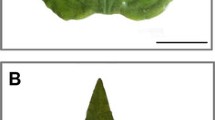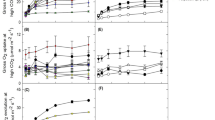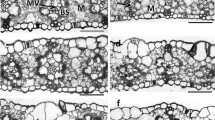Summary
In well-watered plants of Clusia uvitana, a species capable of carbon fixation by crassulacean acid metabolism (CAM), recently expanded leaves gained 5 to 13-fold more carbon during 12 h light than during 12 h dark periods. When water was withheld from the plants, daytime net CO2 uptake strongly decreased over a period of several days, whereas there was a marked increase in nocturnal carbon gain. Photosynthetic rates in the chloroplasts were hardly affected by the water stress treatment, as demonstrated by measurements of chlorophyll a fluorescence of intact leaves, indicating efficient decarboxylation of organic acids and refixation of carbon in the light. Within a few days after rewatering, plants reverted to the original gas exchange pattern with net CO2 uptake predominantly occurring during daytime. The reversible increase in dark CO2 fixation was paralleled by a reversible increase in the content of phosphoenolpyruvate (PEP) carboxylase protein. In wellwatered plants, short-term changes in the degree of dark CO2 fixation were induced by alterations in CO2 partial pressure during light periods: a decrease from 350 to 170 μbar CO2 caused nocturnal carbon gain, measured in normal air (350 μbar), to increase, whereas an increase to 700 μbar CO2, during the day, caused net dark CO2 fixation to cease. The increased CAM activity in response to water shortage may, at least to some extent, be directly related to the reduced carbon gain during daytime.
Similar content being viewed by others
References
Blum H, Baier H, Gross HJ (1987) Improved silver staining of plant proteins, RNA and DNA in polyacrylamide gels. Electrophoresis 8: 93–99
Croat TB (1978) Flora of Barro Colorado Island. Stanford University Press, Stanford
Franco AC, Ball E, Lüttge U (1990) Patterns of gas exchange and organic acid oscillations in tropical trees of the genus Clusia. Oecologia 85: 108–114
Genty B, Briantais JM, Baker NR (1989) The relationship between the quantum yield of photosynthetic electron transport and quenching of chlorophyll fluorescence. Biochim Biophys Acta 990: 87–92
Hammel BE (1986) New species of Clusiaceae from central America with notes on Clusia and synonymy in the tribe Clusieae. Selbyana 9: 112–120
Heber U, Neimanis S, Setlikova E, Schreiber U (1990) Why is photorespiration a necessity for leaf survival under water stress. In: Sinha SK, Sane PV, Agrawal PK, Bhargava SC (eds) Proceedings Intern Congr Plant Physiol, Society Plant Physiol Biochem, New Delhi, pp 581–592
Kyse-Andersen J (1984) Electroblotting of multiple gels: a simple apparatus without buffer tank for rapid transfer of proteins from polyacrylamide to nitrocellulose. J Biochem Biophys Meth 10: 203–209
Laemmli UK (1970) Cleaage of structural proteins during the assembly of the head of bacteriophage T4. Nature 227: 680–685
Lee HJS, Schmitt AK, Lüttge U (1989) The response of the C3—CAM tree, Clusia rosea, to light and water stress. II. Internal CO2 concentration and water use efficiency. J Exp Bot 40: 171–179
Lüttge U (1991) Clusia. Morphogenetische, physiologische und biochemische Strategien von Baumwürgern im tropischen Wald. Naturwissenschaften 78: 49–58
Schmitt J (1990) Rapid concentration changes of phosphoenolpyruvate carboxylase mRNA in detached leaves of Mesembryanthemum crystallinum L. in response to wilting and rehydration. Plant Cell Environ 13: 845–850
Schmitt AK, Lee HJS, Lüttge U (1988) The response of the C3—CAM tree, Clusia rosea, to light and water stress. I. Gas exchange characteristics. J Exp Bot 39: 1581–1590
Schreiber U, Schliwa U, Bilger W (1986) Continous recording of photochemical and nonphotochemical fluorescence quenching with a new type of modulation fluorometer. Photosynth Res 10: 51–62
Wang J, Trevor L (1986) Immunology in Plant Science. Cambridge University Press, Cambridge
Willis JC (1973) A dictionary of the flowering plants and ferns. Cambridge University Press, Cambridge
Winter K (1979) Effect of different CO2 regimes on the induction of crassulacean acid metabolism in Mesembryanthemum crysallinum. Aust J Plant Physiol 6: 589–594
Winter K (1985) Crassulacean acid metabolism. In: Barber J, Baker NR (eds), Photosynthetic Mechanisms and the Environment, Elsevier, Amsterdam, pp 329–387
Winter K, Demmig B (1987) Reduction state of Q and nonradiative energy dissipation during photosynthesis in leaves of a crassulacean acid metabolism plant, Kalanchoe daigremontiana Hamet et Perr. Plant Physiol 85: 1000–1007
Winter K, Gademann R (1991) Daily changes in CO2 and water vapor exchange, chlorophyll fluorescence, and leaf water relations in the halophyte Mesembryanthemum crystallinum during the induction of crassulacean acid metabolism in response to high NaCl salinity. Plant Physiol 95: 768–776
Winter K, Königer M (1991) Dry matter production and photosynthetic capacity in Gossypium hirsutum L. under conditions of slightly suboptimum leaf temperatures and high levels of irradiance. Oecologia 87: 190–197
Winter K, Schramm MJ (1986) Analysis of stomatal and nonstomatal components in the environmental control of CO2 exchange in leaves of Welwitschia mirabilis. Plant Physiol 82: 173–178
Winter K, von Willert DJ (1972) NaCl-induzierter Crassulaceen-Säurestoffwechsel bei Mesembryanthemum crystallinum. Z Pflanzenphysiol 67: 166–170
Winter K, Lesch M, Diaz M (1990) Changes in xanthophyll-cycle components and in fluorescence yield in leaves of a crassulacean-acid-metabolism plant, Clusia rosea Jacq., throughout a 12-hour photoperiod of constant irradiance. Planta 182: 181–185
Author information
Authors and Affiliations
Rights and permissions
About this article
Cite this article
Winter, K., Zotz, G., Baur, B. et al. Light and dark CO2 fixation in Clusia uvitana and the effects of plant water status and CO2 availability. Oecologia 91, 47–51 (1992). https://doi.org/10.1007/BF00317239
Received:
Accepted:
Issue Date:
DOI: https://doi.org/10.1007/BF00317239




